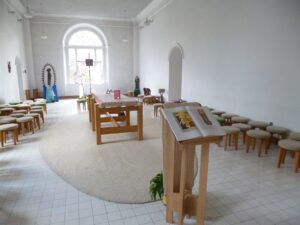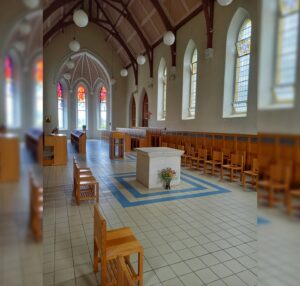Shaping the Assembly: How our buildings form us in worship,
ed. by Thomas O’Loughlin
(Messenger Publications, €25.00/£23.23)
Thomas O’Loughlin is a distinguished scholar who has taught at several institutions in England, retiring as a professor emeritus at the University of Nottingham. This book brings into focus several of his long standing concerns.
It is a compilation of some 18 essays by 19 writers, including the late Richard Hurley, which explore the theme “that liturgy and liturgical space are too often considered as separate unrelated entities”. He has assembled a group of contributors who have nicely varied approaches to this theme.
In our different ways we are all aware of something not right. We will have sat on a Sunday in a church which is only filled with a fraction of the people who would have been there a generation or so ago. The sense of disconnection will have left many feeling only too deeply a sense of isolation which they would love to replace.
If we are to have fewer people at services, surely we can make better use of the space, or create a new kind of space. This is only partly a matter of formal function, or aesthetic considerations. To reuse an old building in the old way may not find the answer. To reuse it in a new way presents its own problems. These essays will present readers, lay and clerical, with a series, not of answers, but effective suggestions.

Heart
At the heart of the matter the editor suggests were two aspects of the new Christian faith that moved the very earliest Christians: the need for a place where they could assemble as a group was important; but also, quite separately, a need to celebrate “the supper of the lamb”.
These carried already cultural echoes of the paschal celebration, itself taking place within a familial group, and a gathering in the synagogue, which was of a different ceremonial character. Today these two aspects still need to be provided for: intimacy of devotion and the social needs of people working together. Those creating a place for Christians today still have to recognise and differentiate these needs – which in fact is not always done. The gathering is not always social, the sharing of the broken bread not always intimate.
The changes after Vatican II from 1970 onwards tried to accomplish much, though there was a large number of both priests and laity who wondered why the old ways would not do: they got the job done. But perhaps something more than “getting the job done” is needed.
{{This is a book which must be read in a sympathetic frame of mind, with a willingness to hear some new and different but thought-out ideas in line with Scripture”
But these essays are, as I say, suggestive rather than prescriptive. They seem to be seeking a way not of recreating a glorious past of the middle ages, but drawing new life from what the Gospels themselves actually say and illustrate. Sometimes preserving tradition gets in the way of carrying out the sense of the Gospels.
To pick out for comment individual contributors might be unfair. Nor does a series of 18 summaries give much help.
But having mentioned the late Richard Hurley, a chain of connection from his work on the Liturgy Room at the then Carlow Liturgy Centre, a place whose influence is referred to here by others (pages 215-217). For instance it was the inspiration for what was done at the refitting of the Episcopalian Cathedral in Philadelphia, a pre-Civil War building, of national importance.
Another connection was with St Mary’s Abbey in Waterford, established by English Cistercian nuns in 1932 with help from Mount Melleray (all pictured).

Willingness
This is a book which must be read in a sympathetic frame of mind, with a willingness to hear some new and different but thought-out ideas in line with Scripture. Perhaps it is all a matter of Christians thinking more about what it is they are doing, and indeed need to do. With a new movement in the air, this may well be the time to catch hold of the ideas in these pages.
The architect Frederick Debuyst is quoted very appositely on the currents of ideas in this book: “The coming to life of most Vatican II churches can be summed up in one phrase, serving the assembled community in the simplest form.”
The contributors come from Europe and New Zealand. But perhaps this is due to the fact that other social, customary and even colonial matters have influenced Asia, Africa and South America in different ways. However that may be, the perhaps inadvertent outcome gives the text a certain cohesion it might not otherwise have had.
But what we do have is richly insightful and full of interest, and for many, full also of new ideas. (Also some insights into the past. A footnote reveals that Romano Guardini, laying out an establishment at Rothenfels, had one part as a chapel to meet the regulations, and another part as a more flexible and creative way (p 3, ft 4). Even in the 1920s, it seems, a certain amount of guile was needed to achieve what one wanted).
Participated
Many Christian churches have participated in this project and the book is issued also in association with the Alcuin Club. Some five years went into its making, but it is the outcome not of a single conference, but of long periods of sensitive discussion and arrangement.
A brief review can only give a taste of such a book. Nothing will replace the real enrichment of mind and spirit that will come from reading it.


 Peter Costello
Peter Costello Easter Vigil being celebrated in the Philadelphia Episcopalian Cathedral.
Easter Vigil being celebrated in the Philadelphia Episcopalian Cathedral. 